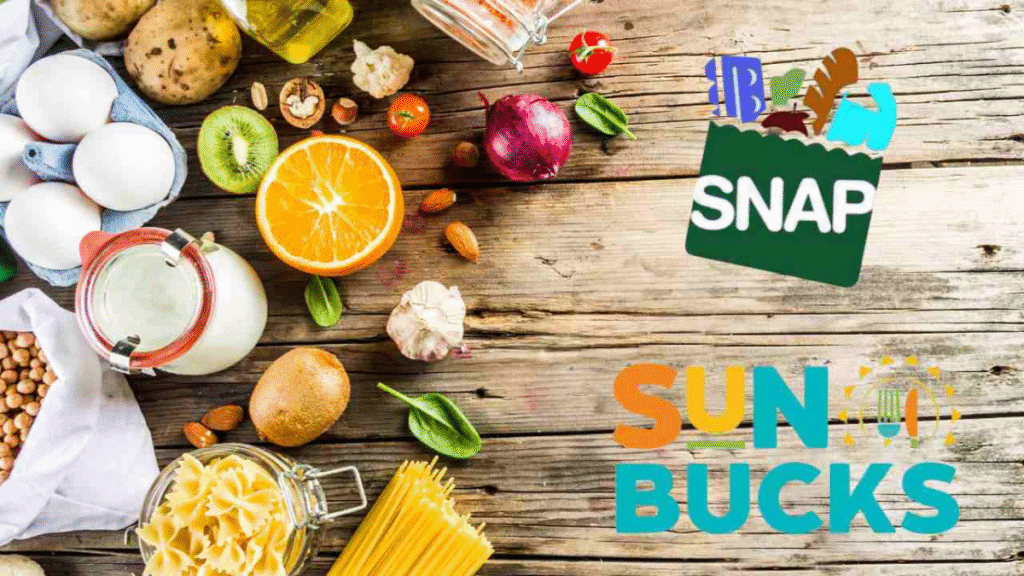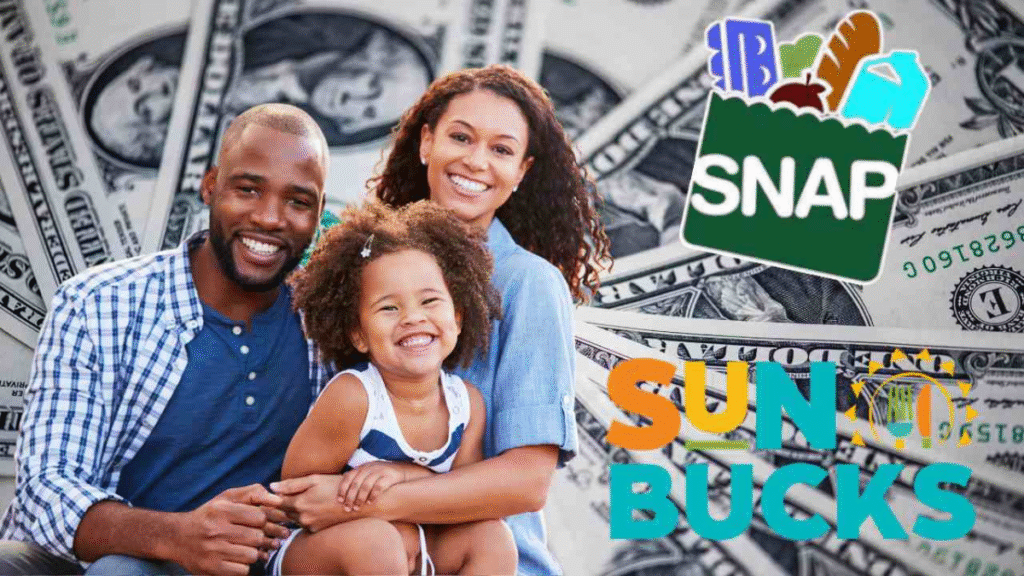Summer can be an exciting time for children, but for many parents, it also brings new challenges. When school is in session, kids can count on breakfast and lunch at school, but when summer break arrives, those meals disappear. This often means families need extra support to keep nutritious food on the table.
That’s where SNAP (Supplemental Nutrition Assistance Program) and SUN Bucks (Summer EBT) step in. These programs provide families with up to $292 per child during the summer, helping make sure children don’t go hungry while school is closed.
This detailed guide explains who qualifies for the benefits, how much support you could receive, and exactly how to apply. Whether you are a working parent, caregiver, teacher, or school administrator, you will find the information here clear and easy to follow.
What Are SNAP and SUN Bucks?
SNAP: Monthly Grocery Help for Low-Income Families
SNAP, often referred to as “food stamps,” is a federal program that helps low-income individuals and families buy groceries. Each month, eligible families receive a set amount of funds on an Electronic Benefits Transfer (EBT) card, which works just like a debit card. SNAP benefits can be used at most major grocery stores, many farmers markets, and even online retailers such as Amazon and Walmart.
For example, if a family qualifies for $150 in SNAP each month, they can shop for food and swipe their EBT card just like they would with a regular bank card.
SUN Bucks: Summer Food Benefits for Kids

SUN Bucks (also called Summer EBT) is a newer program from the USDA that launched nationwide in 2024. It provides an extra $120 per eligible child during summer vacation. This money is meant to replace the free or reduced-price meals that children normally get at school during the academic year.
What’s great about SUN Bucks is that it works in addition to SNAP. Families who already receive SNAP will automatically get SUN Bucks in many states, making it a huge help during a time when grocery bills often rise.
Why Do These Programs Matter?
Food insecurity is a major issue in the United States. In 2023, the USDA reported that more than 12 million children lived in households that struggled to afford enough food. Without the safety net of school meals, summer months can be especially difficult for these families.
Hunger doesn’t just affect children’s stomachs. Studies show that kids who don’t have enough to eat can face:
- More health problems like frequent illnesses and slower growth.
- Difficulty focusing in school and lower test scores.
- Emotional stress and anxiety.
Programs like SNAP and SUN Bucks help reduce these risks by making sure kids have access to balanced meals. In addition, research from Feeding America shows that children who receive regular nutrition are more likely to perform better academically and avoid health problems later in life.
Who Qualifies for SUN Bucks?
Eligibility depends on your family’s situation. Children fall into two categories: automatic eligibility or income-based eligibility.
Automatically Eligible
Your child will likely qualify for SUN Bucks without filling out an application if they:
- Attend a school that participates in the National School Lunch Program (NSLP) or School Breakfast Program (SBP).
- Already receive free or reduced-price meals at school.
- Are enrolled in other public assistance programs like SNAP, TANF, FDPIR, or Medicaid (some states).
- Are in foster care, Head Start, migrant programs, or homeless shelters.
Income-Based Eligibility
If your child does not fall into the categories above, you can still apply. Families generally qualify if their income is at or below 185% of the federal poverty level (FPL).
For example:
- A family of three can earn up to $47,767 annually and still qualify (2025 income limits).
To confirm the exact income cut-off for your household size, check the official USDA income eligibility guidelines.
How to Apply for SUN Bucks

If your child isn’t automatically enrolled, applying is simple.
- Check Eligibility
- Go to your state’s Department of Human Services or EBT website. Many states have online tools to check if you qualify.
- Gather Documents
- Child’s full name and date of birth.
- School name and district.
- Household income and number of family members.
- Proof of residency (like a utility bill or rental agreement).
- Submit Your Application
- Apply through your state’s online portal. Deadlines vary by state, so don’t delay. For example, Michigan’s deadline is August 31, 2025.
- Wait for Confirmation
- You’ll receive a letter, email, or notification through your state’s portal telling you if you were approved.
- Use Your Benefits
- SUN Bucks funds are either mailed to you on a new card or added to your existing EBT card. Use the funds within 122 days, or you may lose them.
If you run into any trouble, call your state’s customer service line or reach out to a local community center for help.
Where Can You Use SNAP and SUN Bucks?
These benefits can be used at many locations:
- Grocery Stores: Walmart, Safeway, Kroger, Aldi, and most major chains.
- Farmers Markets: Many markets accept EBT and even match your dollars through programs like Double Up Food Bucks.
- Online Retailers: Amazon and Thrive Market allow SNAP purchases through the SNAP Online Purchasing Pilot.
Some states also participate in the Restaurant Meals Program (RMP), which allows seniors, homeless individuals, and people with disabilities to use benefits at certain restaurants.
Common Mistakes Families Make
- Waiting too long to apply: Deadlines differ by state, and missing them means losing out on benefits.
- Leaving out information: Incomplete applications cause delays. Double-check all entries.
- Assuming automatic enrollment: Even if your child gets free meals at school, confirm with your school or benefits office.
- Forgetting to use benefits: Funds expire after 122 days. Plan your shopping trips so you use all of the support you receive.
Real-Life Stories
- Maria, a single mom from Texas, shared, “The $240 I received from SUN Bucks for my two kids helped me buy fruits and vegetables I usually skip because of cost. It made summer so much less stressful.”
- Kevin, a principal in Ohio, said, “We held information nights for parents, and so many were shocked they qualified. Just spreading the word helped dozens of families.”
- Dina, a grandmother in Florida, added, “I was worried about feeding my grandkids this summer. Applying for SUN Bucks was easier than I expected, and now I don’t have to worry about meals.”
These stories show how life-changing these benefits can be for families across the country.
Final Thoughts
Summer should be a joyful time for children, not a time when families worry about where their next meal will come from. SNAP and SUN Bucks benefits up to $292 per child can make a huge difference.
If you think you might qualify, check with your state’s benefits office today. Applying early ensures your child has the food they need all summer long.
FAQs
1. What are SNAP and Sun Bucks benefits?
SNAP is the Supplemental Nutrition Assistance Program, and Sun Bucks is a summer food benefits program that helps children access meals when schools are closed.
2. How much can I receive through these benefits?
Eligible families can receive up to $292 in food benefits per child.
3. Who qualifies for SNAP and Sun Bucks?
Low-income households, children who receive free or reduced-price school meals, and families already enrolled in SNAP or other assistance programs may qualify.
4. Do I need to apply separately for Sun Bucks?
In most cases, eligible families are automatically enrolled, but some states may require a separate application.
5. When will the benefits be distributed?
Sun Bucks are usually issued during the summer months, while SNAP benefits are distributed monthly.

